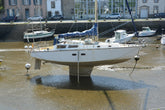As a boat owner, you understand the importance of maintaining every component of your vessel to ensure a safe and enjoyable boating experience. One crucial element that often goes overlooked is the boat bellows. These unassuming yet vital components play a significant role in protecting your boat from water ingress and potential damage.
In this comprehensive guide, we'll dive deep into the world of boat bellows, exploring their function, types, and the importance of proper maintenance. We'll also provide valuable insights on inspecting, maintaining, and replacing these essential components, ensuring your boat remains in top condition for years to come.
What are boat bellows and their function?
Boat bellows, also known as gimbal bellows or stern tube bellows, are flexible, accordion-like structures typically made of durable materials like rubber, neoprene, or reinforced fabric. Their primary function is to create a watertight seal around the propeller shaft, preventing water from entering the boat's interior.
As the propeller shaft rotates and moves during operation, the bellows expand and contract, accommodating this movement while maintaining a secure barrier against water ingress. This crucial component not only protects the boat's interior but also safeguards vital components like the engine and transmission from potential water damage.
Different types of boat bellows
Boat bellows come in various types and materials, each designed to meet specific requirements and operating conditions. Here are some common varieties:
- Rubber Bellows: These bellows are made from high-quality rubber compounds and are known for their durability and resistance to UV rays, ozone, and saltwater exposure.
- Neoprene Bellows: Neoprene is a synthetic rubber material that offers excellent flexibility and resistance to oil, chemicals, and abrasion, making it a popular choice for boat bellows.
- Reinforced Fabric Bellows: These bellows are constructed from reinforced fabrics like polyester or Kevlar, providing exceptional strength and resistance to tearing or puncturing.
- Composite Bellows: Composite bellows combine different materials, such as rubber and fabric, to offer the best of both worlds in terms of flexibility and durability.
Importance of boat bellows for boat maintenance
Proper maintenance and care of boat bellows are crucial for several reasons:
- Water Ingress Prevention: Boat bellows act as a barrier against water entering the boat's interior, protecting vital components from potential damage caused by water intrusion.
- Engine and Transmission Protection: By preventing water ingress, boat bellows safeguard the engine, transmission, and other critical systems from corrosion, rust, and potential failure.
- Structural Integrity: Water ingress can lead to structural issues, such as rot or mold growth, compromising the boat's overall integrity. Maintaining boat bellows helps mitigate these risks.
- Cost Savings: Neglecting boat bellows maintenance can result in costly repairs or replacements down the line, making regular inspections and upkeep a wise investment.
Signs of boat bellows failure
Despite their durability, boat bellows can eventually wear down or fail due to various factors, including age, exposure to harsh conditions, or improper installation. Here are some signs to watch out for that may indicate a failing boat bellows:
- Cracks or Tears: Inspect the bellows for any visible cracks, splits, or tears, which can compromise their ability to create a watertight seal.
- Stiffness or Brittleness: Over time, the bellows material can become stiff or brittle, making it less flexible and less able to accommodate the propeller shaft's movement.
- Leaks or Water Ingress: If you notice water seeping into the boat's interior, it could be a sign of a compromised or failing bellows.
- Excessive Wear or Deformation: Inspect the bellows for signs of excessive wear, deformation, or distortion, which can indicate the need for replacement.
How to inspect and maintain boat bellows
Regular inspections and proper maintenance are essential to ensure the longevity and optimal performance of your boat bellows. Here's how you can inspect and maintain them:
- Visual Inspection: Conduct a thorough visual inspection of the bellows, looking for any signs of cracks, tears, excessive wear, or deformation. Pay close attention to areas where the bellows meet the shaft or hull, as these are common failure points.
- Flexibility Check: Gently flex and manipulate the bellows to assess their flexibility and ensure they can accommodate the propeller shaft's movement without resistance or binding.
- Cleaning and Protection: Clean the bellows regularly with a mild soap and water solution, removing any dirt, debris, or marine growth that may accumulate. Consider applying a protective coating or lubricant recommended by the manufacturer to extend the bellows' lifespan.
- Proper Installation and Alignment: Ensure the bellows are correctly installed and aligned with the propeller shaft and hull. Improper installation or misalignment can cause premature wear or failure.
- Replacement Schedule: Follow the manufacturer's recommended replacement schedule or replace the bellows if they show signs of significant wear or damage.
Boat bellows replacement process
If your boat bellows require replacement, it's essential to follow the proper steps to ensure a successful installation and prevent potential issues. Here's a general overview of the replacement process:
- Preparation: Secure the boat and ensure it's in a stable position. Gather all necessary tools and replacement bellows compatible with your boat's specifications.
- Removal of Old Bellows: Carefully remove the old bellows, following the manufacturer's instructions or seeking professional assistance if needed.
- Inspection and Cleaning: Inspect the surrounding areas, including the propeller shaft and hull, for any signs of damage or corrosion. Clean and prepare the surfaces for the new bellows installation.
- Installation of New Bellows: Carefully install the new bellows, ensuring proper alignment and following the manufacturer's instructions. Secure the bellows in place using the appropriate fasteners or clamps.
- Testing and Adjustment: Once installed, test the bellows by operating the propeller shaft and ensuring proper movement and flexibility. Make any necessary adjustments to ensure a secure and watertight seal.
- Documentation and Maintenance Schedule: Document the replacement date and any relevant information for future reference. Establish a maintenance schedule to monitor the new bellows and ensure their longevity.
Tips for extending the lifespan of boat bellows
To maximize the lifespan of your boat bellows and minimize the need for frequent replacements, consider the following tips:
- Proper Storage: When not in use, store your boat in a covered and protected area to minimize exposure to harsh environmental conditions like UV rays, saltwater, and extreme temperatures.
- Regular Inspections and Maintenance: Adhere to a regular inspection and maintenance schedule, as outlined earlier, to catch any potential issues early and address them promptly.
- Avoid Excessive Strain: Ensure the bellows are not subjected to excessive strain or tension during operation, as this can lead to premature wear or failure.
- Use Recommended Lubricants and Protectants: Follow the manufacturer's recommendations for suitable lubricants or protectants to help extend the bellows' lifespan and maintain their flexibility.
- Proper Installation and Alignment: Ensure the bellows are correctly installed and aligned to prevent unnecessary stress or wear on the material.
- Timely Replacement: When signs of significant wear or damage are present, replace the bellows promptly to avoid potential water ingress and further damage.
Common mistakes to avoid with boat bellows
To ensure the optimal performance and longevity of your boat bellows, it's essential to avoid common mistakes that can lead to premature failure or damage. Here are some pitfalls to watch out for:
- Neglecting Regular Inspections: Failing to conduct regular inspections can lead to undetected issues or damage, potentially resulting in costly repairs or replacements.
- Improper Installation or Alignment: Incorrectly installing or misaligning the bellows can cause excessive strain, wear, or failure, compromising their effectiveness.
- Using Incompatible Lubricants or Protectants: Applying unsuitable lubricants or protectants can degrade the bellows' material, leading to premature failure or compatibility issues.
- Exposing Bellows to Harsh Conditions: Prolonged exposure to UV rays, saltwater, extreme temperatures, or other harsh environmental conditions can accelerate the degradation of the bellows' material.
- Overloading or Excessive Strain: Subjecting the bellows to excessive strain or tension beyond their designed limits can cause cracks, tears, or deformation, leading to potential water ingress.
- Ignoring Signs of Wear or Damage: Failing to address visible signs of wear or damage, such as cracks or leaks, can exacerbate the issue and lead to more extensive and costly repairs.
Conclusion: The significance of boat bellows for a well-maintained boat
Boat bellows may seem like a small and unassuming component, but their importance in maintaining the integrity and safety of your vessel cannot be overstated. By understanding their function, different types, and proper maintenance practices, you can ensure your boat bellows remain in optimal condition, protecting your investment and providing peace of mind on the water.
Remember, regular inspections, timely replacements, and adherence to best practices are key to maximizing the lifespan of your boat bellows and preventing potential water ingress and damage. Don't overlook this crucial component – prioritize its care and maintenance for a well-maintained, seaworthy boat that delivers years of enjoyment on the water.


![Veratron OL 43 Smart Marine Monitoring TFT Display [B00126101]](http://arcmarine.co/cdn/shop/files/111172XL_165x.jpg?v=1763678982)
![Veratron Suzuki VMH-35 PWM Display w/Sumitomo Connectors [B00204101]](http://arcmarine.co/cdn/shop/files/111170XL_165x.jpg?v=1763678982)



